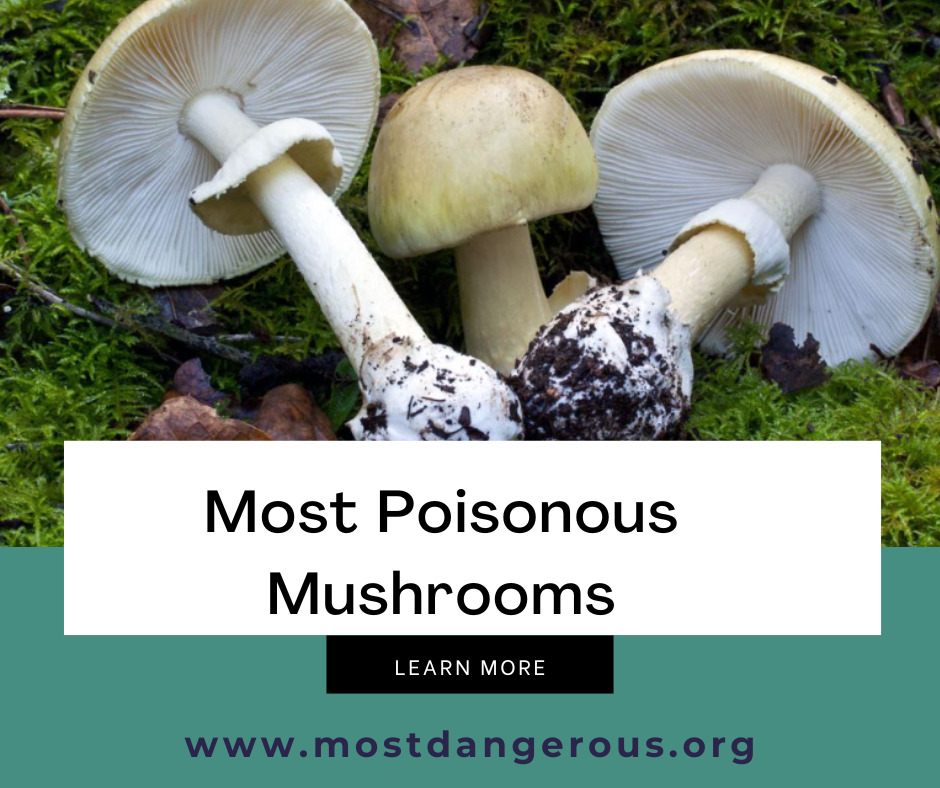Mushrooms are often celebrated for their culinary delights and medicinal properties, but lurking among their ranks are some of the most toxic substances found in nature.

In this article, we delve into the shadowy world of poisonous mushrooms, uncovering the deadliest varieties and the dangers they pose to unsuspecting foragers and curious adventurers.
From their deceptively innocuous appearances to their devastating effects on the human body, these mushrooms serve as a sobering reminder of nature’s capacity for both wonder and peril.
Click here to also read about Most Dangerous Mountains To Climb: Conquering the Killers.
5 Most Poisonous Mushrooms
1. Death Cap (Amanita phalloides)
Widely regarded as the most poisonous mushroom in the world, the Death Cap contains potent toxins that can cause severe liver and kidney damage, often leading to death if ingested.
With its attractive appearance and lack of distinct odor, this deadly fungus is responsible for numerous fatalities each year, highlighting the importance of accurate identification when foraging for wild mushrooms.

2. Destroying Angel (Amanita bisporigera)
Resembling its innocuous relatives, the Destroying Angel is a lethal mushroom capable of causing rapid and irreversible damage to internal organs.
Its pure white appearance and graceful shape belie the deadly toxins it harbors, making it a particularly treacherous species for inexperienced mushroom hunters.

3. Angel of Death (Amanita ocreata)
Another member of the Amanita genus, the Angel of Death, also known as the Western Destroying Angel, contains potent toxins that target the liver and kidneys.
Found predominantly in western North America, this deadly mushroom poses a significant risk to those who mistake it for edible varieties, underscoring the importance of caution and expertise when foraging in the wild.

4. Deadly Galerina (Galerina marginata)
Often mistaken for edible mushrooms due to their small size and brownish appearance, Deadly Galerinas contain deadly toxins that can cause liver and kidney failure if ingested.
Found in various habitats worldwide, these poisonous fungi serve as a stark reminder of the need for meticulous identification and caution when collecting wild mushrooms for consumption.

5. Angel Wing (Pleurocybella porrigens)
Angel Wing mushrooms (Pleurocybella porrigens) are delicate fungi found in temperate forests worldwide.
They grow on decaying wood and have thin, creamy-white caps resembling angel wings.
Despite their appealing appearance, they are toxic if consumed, causing symptoms like nausea and abdominal pain.
Angel Wing mushrooms play a role in forest ecosystems as decomposers.
However, caution is advised as they should not be consumed due to their potential toxicity.

Conclusion
While the world of mushrooms offers a diverse array of culinary delights and medicinal wonders, it also harbors some of the most deadly toxins known to man.
The mushrooms highlighted in this article represent just a fraction of the dangerous varieties found in nature, serving as a sobering reminder of the importance of caution, expertise, and proper identification when foraging for wild mushrooms.
By arming ourselves with knowledge and respect for these potentially lethal fungi, we can safely enjoy the wonders of the natural world without falling victim to its darker side.
ALSO READ:
- Top 10 Most Dangerous Drugs in the World: Unveiling the Substances That Pose the Greatest Risks
- 10 Most Dangerous Birds in the World: Exploring the World’s Most Deadly Birds
- The Top 10 Most Dangerous Ocean Animals: Exploring the Depths of Danger
- Understanding the Danger: The 15 Most Dangerous Spiders You Should Know About
